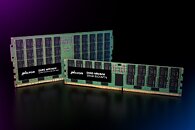- Joined
- Oct 9, 2007
- Messages
- 47,296 (7.53/day)
- Location
- Hyderabad, India
| System Name | RBMK-1000 |
|---|---|
| Processor | AMD Ryzen 7 5700G |
| Motherboard | ASUS ROG Strix B450-E Gaming |
| Cooling | DeepCool Gammax L240 V2 |
| Memory | 2x 8GB G.Skill Sniper X |
| Video Card(s) | Palit GeForce RTX 2080 SUPER GameRock |
| Storage | Western Digital Black NVMe 512GB |
| Display(s) | BenQ 1440p 60 Hz 27-inch |
| Case | Corsair Carbide 100R |
| Audio Device(s) | ASUS SupremeFX S1220A |
| Power Supply | Cooler Master MWE Gold 650W |
| Mouse | ASUS ROG Strix Impact |
| Keyboard | Gamdias Hermes E2 |
| Software | Windows 11 Pro |
JEDEC Solid State Technology Association, the global leader in the development of standards for the microelectronics industry, proudly announces upcoming standards for advanced memory modules designed to power the next generation of high-performance computing and AI applications. JEDEC today revealed key details about its upcoming standards for DDR5 Multiplexed Rank Dual Inline Memory Modules (MRDIMM) and a next-generation Compression-Attached Memory Module (CAMM) for LPDDR6. The new MRDIMM and CAMM for LPDDR6 are set to revolutionize the industry with unparalleled bandwidth and memory capacity.
The JEDEC MRDIMM standard is set to deliver up to twice the peak bandwidth of native DRAM, enabling applications to surpass current data rates and achieve new levels of performance. It maintains the same capacity, reliability, availability, serviceability (RAS) features as JEDEC RDIMM. The committee aims to double the bandwidth to 12.8 Gbps and increase the pin speed. MRDIMM is envisioned to support more than two ranks and is being designed to utilize standard DDR5 DIMM components ensuring compatibility with conventional RDIMM systems.

DDR5 MRDIMMs offer an innovative, efficient new module design to enhance data transfer rates and overall system performance. Multiplexing allows multiple data signals to be combined and transmitted over a single channel, effectively increasing the bandwidth without the need for additional physical connections and providing a seamless bandwidth upgrade to enable applications to exceed DDR5 RDIMM data rates. Other planned features include:
As a follow-on to JEDEC's JESD318 CAMM2 Memory Module standard, JC-45 is developing a next-generation CAMM module for LPDDR6 targeting a maximum speed greater than 14.4 GT/s. As planned, the module will also offer a 24-bit subchannel, a 48-bit channel and a connector array.
Both projects are in development in JEDEC's JC-45 Committee for DRAM Modules. JEDEC encourages companies to join and help shape the future of JEDEC standards. Membership grants access to pre-publication proposals and provides early insights into active projects such as MRDIMM.
View at TechPowerUp Main Site
The JEDEC MRDIMM standard is set to deliver up to twice the peak bandwidth of native DRAM, enabling applications to surpass current data rates and achieve new levels of performance. It maintains the same capacity, reliability, availability, serviceability (RAS) features as JEDEC RDIMM. The committee aims to double the bandwidth to 12.8 Gbps and increase the pin speed. MRDIMM is envisioned to support more than two ranks and is being designed to utilize standard DDR5 DIMM components ensuring compatibility with conventional RDIMM systems.

DDR5 MRDIMMs offer an innovative, efficient new module design to enhance data transfer rates and overall system performance. Multiplexing allows multiple data signals to be combined and transmitted over a single channel, effectively increasing the bandwidth without the need for additional physical connections and providing a seamless bandwidth upgrade to enable applications to exceed DDR5 RDIMM data rates. Other planned features include:
- Platform compatibility with RDIMM for flexible end-user bandwidth configuration
- Utilization of standard DDR5 DIMM components including DRAM, DIMM Form Factor & Pinout, SPD, PMIC, and TS for ease of adoption
- Efficient I/O scaling using RCD/DB logic process capability
- Leverage existing LRDIMM ecosystem for design and test infrastructure
- Support for Multi-generational scaling to DDR5-EOL
As a follow-on to JEDEC's JESD318 CAMM2 Memory Module standard, JC-45 is developing a next-generation CAMM module for LPDDR6 targeting a maximum speed greater than 14.4 GT/s. As planned, the module will also offer a 24-bit subchannel, a 48-bit channel and a connector array.
Both projects are in development in JEDEC's JC-45 Committee for DRAM Modules. JEDEC encourages companies to join and help shape the future of JEDEC standards. Membership grants access to pre-publication proposals and provides early insights into active projects such as MRDIMM.
View at TechPowerUp Main Site



